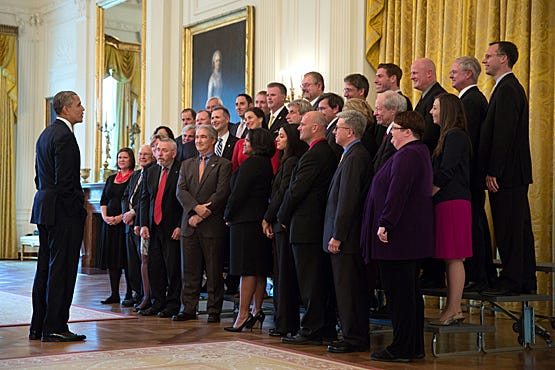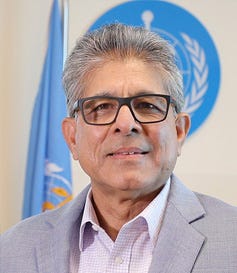Hamid Jafari Led Team Which Largely Erased Polio In India
Pakistani doctor Hamid Jafari led WHO and government healthcare team which tackled polio in India
(Photo: President Barack Obama with winners and finalists of the Sammie Awards, 2013, including Hamid Jafri. Courtesy: Obama White House.)
October 6, 2024
Last month, six United States government employees were awarded the Samuel J. Heyman Service to America Medals. Since 2002, the Partnership for Public Service, a Washington DC based philanthropy founded by Heyman, has awarded the medal, known as the Sammies, to 760 federal government employees.
“Each spring, the most interesting organization that no one’s ever heard of collects nominations for the most important awards that most people will never know were handed out,” writes Michael Lewis in a Washington Post profile of Christopher Mark, one of the Sammie winners this year.
One Sammie, notes Lewis, “went to a doctor at the Centers for Disease Control and Prevention who designed and ran a program that delivered a billion vaccinations and eradicated polio in India.” The doctor is Hamid Jafari, who won the award in 2013, for managing a public health program run jointly by the government of India and the World Health Organization (WHO).
Polio is a contagious viral illness that mainly affects children and can cause paralysis, difficulty breathing and sometimes death. In the late 1940s to the early 1950s, polio crippled about 35,000 people each year in the United States alone. With the widespread use of vaccines developed in the 1950s, the United States became polio free by 1979.
Between 2006 and 2009, reports of annual polio cases in India ranged from 559 to 874, comprising 43 percent of the confirmed cases worldwide. For years, experts doubted whether polio could be eradicated in India because of the size of the population and the fact that the virus has persisted in the poorest communities with the worst sanitation and water.
Each year, between 2008 and 2011, Jafari oversaw the delivery of the polio vaccine to 172 million young children in India. Many of these children were living in hard-to-reach and high-risk areas. Jaffari directed a staff of more than 2,300 people as well as about 2.3 million vaccinators who visited more than 60 million houses several times a year. Subsequent surveys confirmed that 99 percent of children in the hardest to reach and highest-risk areas were protected from polio.
The program included vaccination campaigns, routine immunization, mobile vaccination teams, research that led to the development and use of more effective polio vaccines in a setting of poor sanitation and high rates of diarrhea.
The best way to tackle the problem of children missed by vaccination teams, Jaffari said in a statement, was by “weaving a tight net that did not allow children to slip through the program.” To reach the critical population of newborn babies, for example, he had workers routinely register the babies house to house to make sure they were vaccinated.
There was a major problem in Bihar, a very poor state that was the last refuge of the virus in India. Vast areas of the state flooded every summer from snow melting in the Himalayas. Jafari’s teams used boats and motorcycles and waded through water to reach the children.
(Photo: Hamid Jafari, courtesy WHO.)
Jafari, 65-years-old, is a Director of Polio Eradication at WHO, leading efforts in 22 countries. Till 2019, he was at the U.S. Centers for Disease Control and Prevention, (CDC) Atlanta, including on loan to the WHO for the polio-eradication program in India, 2007-2012, and as a medical officer, 1996-2002. Since his assignment in India, he worked on programs to eradicate polio in Pakistan, Afghanistan, and Nigeria, the three countries where polio persisted, using strategies that worked in India. Jafari also played a key role in the CDC’s efforts to end the global tuberculosis epidemic.
He has published more than 100 scientific papers and book chapters on pathogenesis of infectious diseases, polio eradication and other vaccine-preventable diseases and global health security. He is certified by the American Board of Pediatrics in Pediatric Infectious Diseases and is a graduate of CDC’s Epidemic Intelligence Service program.
Jafari completed his residency in Pediatrics at Dartmouth Medical School, a Pediatric Infectious Disease fellowship at the University of Texas Southwestern Medical Center, Dallas, and a research fellowship at Harvard Medical School. He obtained his MBBS degree from Sind Medical College, Karachi University, Pakistan.
Since 1988, more than $18 billion has been spent through WHO and UNICEF in support of polio eradication activities carried out in over 70 countries. These contributions have helped reduce the incidence of polio by 99% and have laid the foundation for an infrastructure to be used beyond polio eradication.
By January 2011, following the government and WHO’s effort led by Jafari, the number of polio cases in India reached zero. A year later, the country did not witness a single case of polio over a 12-month period.
In 2022, several cases of the polio virus were reported including 14 in Pakistan and one each in Israel and Malawi. The virus was also found in sewage in Britain and in New York City.
In India, recent data shows that the pace of administration of the polio vaccine has slowed down. In August, a case of polio was detected in a child in Meghalaya, a state in northeast India. Vaccine “coverage was lowest among the poorest households where the education levels of the female head of the family were not advanced,” according to a report in The Hindu.
It is likely that others will be inspired by Jafari’s work to continue to tackle polio and other infectious diseases in India as well as elsewhere. As the Partnership for Public Service notes on its website, the Sammie awards to Jafari and others “shines the spotlight on remarkable accomplishments that benefit the nation, seeks to build trust in our government and inspires more people to consider careers in public service.”
While presenting the award to Jafari and others in 2013, then President Barack Obama said, “They are not superheroes, but they come awfully close.”




